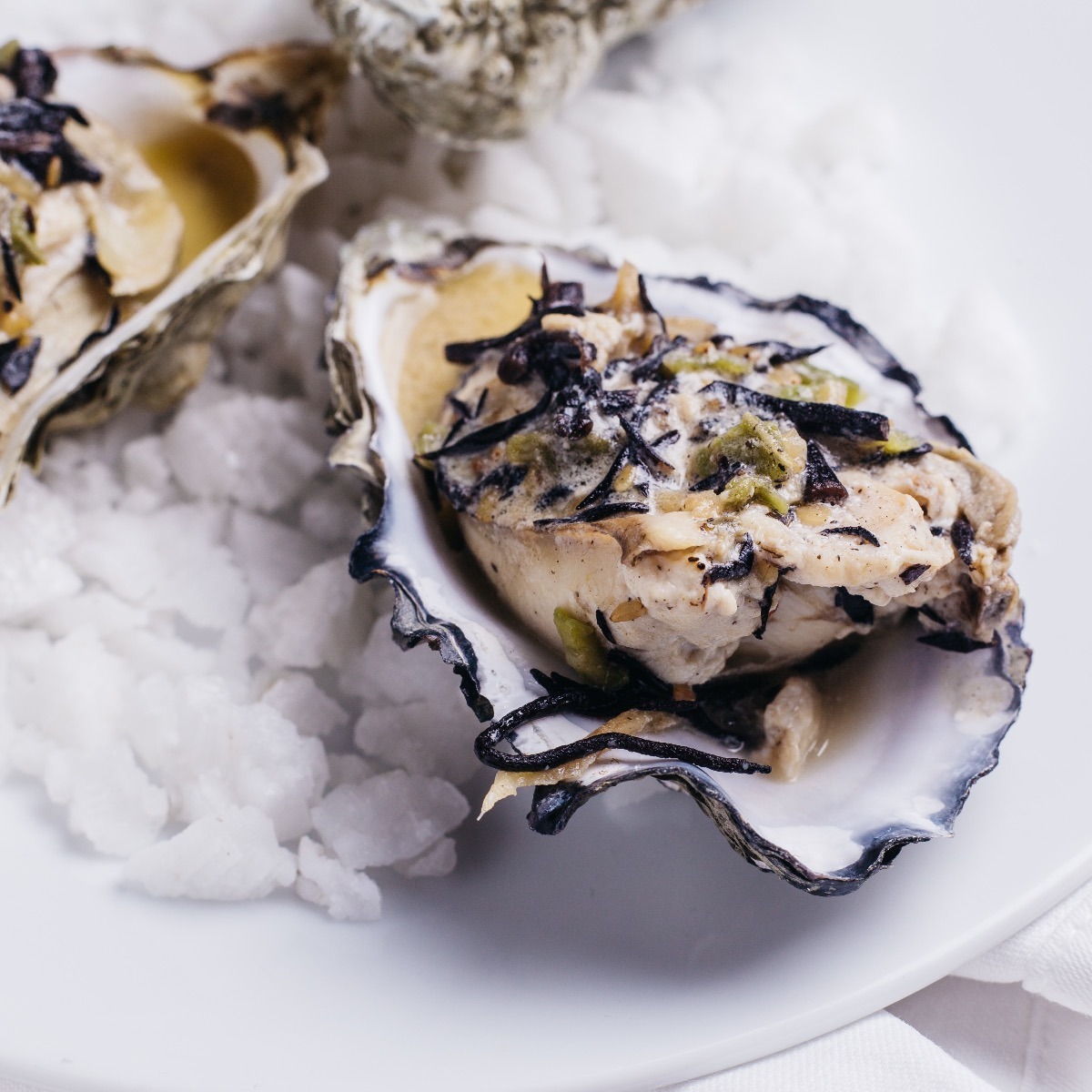All About Oysters
Oysters are one of the most versatile and celebrated seafoods around the world, cherished for their delicate flavor and unique texture. Whether enjoyed raw on the half shell, baked, grilled, or incorporated into stews and sauces, oysters offer a culinary experience that spans cultures and traditions. Known for their briny taste and delicate sweetness, oysters are often a symbol of luxury and indulgence, yet they can also be found in casual, everyday meals.
Beyond their taste, oysters boast numerous health benefits. Packed with protein, essential minerals like zinc and iron, and omega-3 fatty acids, they make a nutritious addition to any diet. Their sustainability also makes them a popular choice for environmentally conscious diners, as oysters filter and clean water, helping to improve the marine ecosystem.
In this post, I’ll dive into the different types of oysters, how to enjoy them, and why they are such a beloved delicacy. From the best preparation methods to tips on pairing with wine, we’ll explore everything you need to know to appreciate oysters in all their glorious forms.
Hmm, Hmm, Hmm. We do love oysters in our house. I personally only like them freshly shucked and served with cocktail sauce or mignonette sauce but my wife and daughters like them baked, fried or even grilled.
What Exactly Are Oysters?
Oysters are a type of shellfish prized for their unique flavor and nutritional value. You can find them in coastal areas worldwide, where people harvest and serve them fresh, cooked, or raw. Oysters are incredibly versatile, enjoyed in many ways, and have a long cultural significance history.
Oysters stand out for their distinct flavor, often described as briny or salty. This taste comes from the high concentration of salt and minerals in the waters where oysters grow. The flavor can also vary depending on the water type and the harvest season, with some oysters tasting sweeter while others lean savory or even metallic.
Oysters provide an excellent source of protein and essential nutrients, including vitamins A, B12, and D, along with iron, zinc, and copper. Their low calorie and fat content offer a healthy choice for those looking to maintain a balanced diet.
Oysters on the Half-Shell

One of the most popular ways to enjoy oysters is raw, served on the half-shell with a squeeze of lemon juice and a dash of hot sauce. This traditional method allows their unique flavor to shine. Some people prefer to chew their oysters, while others swallow them whole. Either way, eating raw oysters provides a memorable culinary experience.
You can also enjoy oysters by cooking them. Frying, grilling, or steaming transforms their texture and flavor, but they remain delicious and nutritious. Breaded and fried, they create a crispy, savory snack, or grilled with garlic butter sauce, they offer a more sophisticated taste.
History
Oysters have a long history, dating back to ancient times. The ancient Romans and Greeks considered them a luxury food, and Native American tribes in North America also enjoyed them. They were often used in religious ceremonies and were believed to have medicinal properties.
Today, oysters remain highly prized for their unique flavor and nutritional value. From New Orleans to Paris, they are enjoyed worldwide, and cities like New Orleans and Galway, Ireland, host famous oyster festivals. However, some people avoid raw oysters due to foodborne illness risks like norovirus or Vibrio bacteria. To reduce this risk, ensure oysters are harvested and stored correctly and check for any signs of spoilage or contamination before eating.
They are a fascinating and delicious food with a rich history and cultural significance. Whether raw or cooked, oysters offer numerous health benefits, from being a source of protein and omega-3 fatty acids to providing essential vitamins and minerals. With their unique flavor and nutritional value, oysters will remain a beloved delicacy for many years.
Nutritional Value
They provide a nutrient-dense food that is low in calories and high in several essential vitamins and minerals. Here are some key nutritional benefits of oysters:
Protein – Oysters offer a good source of protein, essential for building and repairing tissues in the body.
Omega-3 fatty acids – Oysters deliver a rich source of omega-3 fatty acids, which support brain health and reduce the risk of heart disease.
Vitamins and minerals – Oysters are high in vitamins and minerals, including vitamin B12, iron, zinc, copper, selenium, and vitamin D.
Low in calories – With just six calories per raw oyster, oysters make an excellent choice for those managing their calorie intake.
Low in fat and cholesterol – Oysters contain little fat and no cholesterol, making them a heart-healthy food.
Boosts immunity – Oysters offer high levels of zinc, which are essential for maintaining a healthy immune system and promoting wound healing.
The nutritional content of oysters can vary depending on the species, growing conditions, and other factors. However, oysters remain a nutrient-dense food that provides various health benefits as part of a balanced diet.
Some Types of Oysters
Oysters come in a variety of types and flavors, each with unique characteristics. Here are some popular varieties and a brief description of their taste:
Kumamoto – Originally from Japan, these small oysters are now grown in the Pacific Northwest. They feature a deep, bowl-shaped shell and offer a sweet, buttery flavor with a slightly metallic finish.
Blue Point – Named after the location in New York where they were first harvested, these oysters have a briny flavor, a slightly sweet finish, and a crisp, firm texture.
Pacific – Also known as the Japanese oyster, this variety is one of the most widely cultivated in the world. It boasts a sweet, creamy flavor with a slightly metallic finish and a plump, firm texture.
Malpeque – Harvested from Prince Edward Island, these oysters have a salty, briny flavor with mild sweetness and a clean, crisp finish.
Olympia – Native to the Pacific Northwest, these small oysters have a sweet, buttery flavor, a slightly metallic finish, and a tender, delicate texture.
Belon – Also known as the European Flat oyster, Belons offer a unique, earthy flavor with a slightly metallic finish. They are rare and prized by oyster lovers.
Wellfleet – Named after the Massachusetts location where they are harvested, these oysters feature a briny flavor, a sweet, buttery finish, and a firm, meaty texture.
Beau Soleil – Grown in the shallow waters of New Brunswick, Canada, they offer a sweet, mild flavor with a crisp, clean finish and a plump, meaty texture.
Fanny Bay – Harvested from the cold, nutrient-rich waters of Vancouver Island, these oysters have a sweet, delicate flavor with a slightly metallic finish and a firm, meaty texture.
Coffin Bay – Grown in South Australia’s pristine waters, these oysters have a sweet, briny flavor with a clean, crisp finish and a tender, delicate texture.
Keep in mind that oyster flavor can vary depending on the time of year and the location where they are grown, so it’s always a good idea to ask your local oyster purveyor for recommendations based on what is fresh and in season.
Five Fun Facts About Oysters
- They can change their gender – They are born as males but can change their gender multiple times throughout their life, a process known as protandry.
- They filter large amounts of water – A single oyster can filter up to 50 gallons of water per day, helping maintain water quality in coastal ecosystems.
- They have been used as currency – In ancient Rome, oysters were considered a luxury food and were often used as currency.
- They were popular in the Wild West – Oysters were a favorite food of cowboys and settlers in the 19th-century American West, shipped inland and often served in saloons and restaurants.
- They can produce pearls – Although rare, oysters can produce pearls when an irritant, such as a grain of sand, gets trapped inside their shell. Over time, the oyster covers the irritant with layers of nacre, forming a pearl.
- What Do They Eat?
Oysters are filter feeders, primarily consuming phytoplankton (microscopic algae), bacteria, detritus, and organic particles in the water. They draw in water through their gills, trapping food with mucus and then digesting the particles. By filtering water, oysters help improve water quality, removing excess nutrients and particulates. Their diet and growth depend on water quality and plankton availability, making them vital for maintaining healthy marine ecosystems.
Maturity
Oysters take anywhere from 1 to 3 years to reach maturity, depending on the species, growing conditions, and other factors. The time it takes for an oyster to mature also depends on the desired market size and the cultivation method.
Oysters are generally considered ready for consumption when they reach a market size of 3 inches or larger. However, some oyster lovers enjoy smaller oysters, known as “cocktail” or “petite” oysters, which can be harvested at a younger age.
The age of oysters at consumption also depends on whether they are wild-caught or farmed. Wild oysters typically grow older than farmed oysters by the time they are harvested, as they have had more time to develop in their natural environment.
Their taste and texture can vary depending on their age and size. Some oyster lovers prefer larger, more mature oysters for their robust flavor and meaty texture, while others favor smaller, younger oysters for their delicate flavor and tender texture.
What Do Oysters Taste Like?

Oysters offer a unique taste, often described as briny, salty, and slightly metallic. Their flavor can also reflect the growing environment, including the type of water, nutrients, and other factors that contribute to their taste.
In addition to their salty and briny flavor, oysters can have a mild sweetness and a buttery, creamy texture. Some oyster lovers even describe the taste as “umami,” a Japanese term used to describe a savory, meaty flavor often associated with foods like mushrooms, soy sauce, and miso.
The taste of oysters also varies depending on how they are prepared and served. Some people enjoy oysters raw, with just a squeeze of lemon juice or a dash of hot sauce to enhance their natural flavor. Others prefer to cook oysters by grilling, frying, or roasting, which can add a smoky, charred flavor to the meat.
Ultimately, the taste of oysters comes down to personal preference, and trying different varieties and preparation methods is the best way to discover what you enjoy most.
Sauces to Enjoy with Oysters
Raw oysters are often served with a variety of sauces that enhance their flavor and texture. Here are some popular sauces to enjoy with raw oysters:
Cocktail sauce – Made from ketchup, horseradish, lemon juice, and Worcestershire sauce, this sauce offers a slightly sweet and tangy flavor that complements the briny taste of oysters.
Mignonette sauce – Composed of vinegar, shallots, and black pepper, this sauce provides a tangy and slightly acidic flavor that pairs well with the sweetness of raw oysters.
Hot sauce – Hot sauces, like Tabasco, add a spicy kick to the mild flavor of raw oysters.
Lemon juice – Squeezing fresh lemon juice over raw oysters is a simple way to enhance their flavor. The acidity of lemon juice helps balance the oysters’ brininess.
Horseradish sauce – Made from grated horseradish root, sour cream, and lemon juice, this sauce offers a pungent and spicy flavor that adds depth to the taste of raw oysters.
Garlic butter – Drizzling melted garlic butter over raw oysters adds richness and flavor, while also mellowing out the oysters’ brininess.
These are just a few examples of the sauces people enjoy with raw oysters. Some prefer oysters plain, without any sauce or toppings. Ultimately, the choice of sauce depends on personal taste preferences and the type of oyster being served.
Ways to Eat
Eating oysters offers a unique and enjoyable experience, but it can feel intimidating if you’ve never tried them. Here are some general tips on how to eat oysters:
First, ensure the oysters you eat are fresh and properly handled and stored. Look for oysters that are tightly closed or have a slightly open shell that snaps shut when tapped.
Before eating, clean the oysters by scrubbing them under cold running water with a stiff brush. This removes dirt, sand, or other debris from the shell.
To shuck an oyster, hold it with a towel or a specialized oyster-sucking tool, and insert the blade of a shucking knife into the shell’s hinge. Twist the knife to pop open the shell, and then run the blade along the inside of the top shell to release the oyster from the bottom shell.
Once shucked, add toppings such as lemon juice, hot sauce, cocktail sauce, or mignonette sauce to enhance the flavor. However, some people prefer to eat oysters plain, without any toppings.
To eat the oyster, tilt the shell toward your mouth and use a small fork or your fingers to remove the meat from the shell. Chew a few times to release its flavors and texture, then swallow.
Oysters pair well with champagne, white wine, or a cold beer, which complement their briny flavor and refreshing taste.
Eating oysters can be a fun experience, but remember to handle and shuck them carefully to avoid injury. If you feel uncomfortable shucking your oysters, ask a professional or experienced shucker to do it for you.
Cooking with Oysters
Oysters are a versatile seafood that cooks in many ways to create delicious and flavorful dishes. Here are some popular methods to cook oysters:
Grilled oysters offer a popular summer option. To make grilled oysters, place shucked oysters on a hot grill and cook until the edges curl. Top with garlic butter, cheese, or other toppings.
Fried oysters make a classic Southern dish, served as an appetizer or main course. To make fried oysters, dip shucked oysters in seasoned flour, egg wash, and breadcrumbs, then fry until golden brown.
Steamed oysters provide a simple and healthy cooking method. To make steamed oysters, place shucked oysters in a pot with a small amount of water, white wine, or beer. Cover and steam until the oysters open.
Oyster stew is a classic, easy-to-make dish. To make oyster stew, cook shucked oysters in a creamy broth with butter, onions, celery, and other seasonings.
Oysters Rockefeller offer a rich and flavorful option for special occasions. To make Oysters Rockefeller, top shucked oysters with spinach, breadcrumbs, garlic, butter, and Parmesan cheese, then bake until golden brown.
Raw oysters are often served on the half-shell as an appetizer or snack. To prepare raw oysters, shuck them and serve with lemon wedges, cocktail sauce, mignonette sauce, or other condiments.
Oysters Rockefeller

Oysters Rockefeller is a classic dish that originated in New Orleans in the late 19th century. Jules Alciatore, the owner of Antoine’s restaurant, is said to have created it while searching for a new way to serve oysters to his customers. He named the dish after John D. Rockefeller, the wealthiest man in America at the time, because it was said to be as rich as he was.
The original recipe for Oysters Rockefeller remains a closely guarded secret. However, it is generally believed to include a mixture of spinach, breadcrumbs, butter, and herbs, topped with cheese and baked until golden brown. Some variations of the recipe also include bacon or other meats.
Oysters Rockefeller
Ingredients
- 24 fresh oysters shucked and on the half shell
- ¼ cup butter unsalted
- ¼ cup shallots chopped
- ¼ cup celery chopped
- ¼ cup green onions chopped
- 2 cloves garlic minced
- ½ cup fresh spinach chopped
- ½ cup breadcrumbs
- ¼ cup Parmesan cheese freshly grated
- ¼ cup Pernod an anise-flavored liquor
- salt and pepper to taste
- lemon wedges for serving
Instructions
- Preheat the oven to 450° F.
- In a large skillet, melt the butter over medium heat. Add the shallots, celery, green onions, and garlic, and cook until soft and translucent, about 5 minutes.
- Add the spinach to the skillet and cook until wilted, about 2 minutes.
- Remove the skillet from the heat and stir in the breadcrumbs, Parmesan cheese, and Pernod—season with salt and pepper to taste.
- Spoon the mixture over the oysters on the half shell, dividing it evenly among them.
- Place the oysters on a baking sheet and bake until the topping is golden brown and the oysters are cooked through, about 10 minutes.
- Serve hot with lemon wedges on the side.
Notes
How Do They Procreate?
You might wonder how oysters produce offspring. As bivalve mollusks, they possess a hinged two-part shell and feed by filtering water. Like other bivalves, oysters reproduce sexually.
Most oysters are either male or female, although some species can change sex over time. During the spawning season, which occurs in warmer months, mature oysters release eggs or sperm into the water. Fertilization happens when sperm meets eggs in the water column. The fertilized eggs then develop into free-swimming larvae called veligers.
Veligers, which are microscopic, drift in the water column for about two weeks, feeding on plankton. During this time, they grow and eventually transform into juveniles called spat. Spats, though still tiny, begin forming shells and attach to hard surfaces like rocks or other oyster shells. Once attached, they grow and mature, a process that takes 1 to 3 years depending on the species.
Oysters can also reproduce asexually through fragmentation. In this process, a piece of the oyster’s mantle or body detaches and forms a new individual, essentially cloning the original oyster. However, fragmentation is less common than sexual reproduction and typically occurs only when the oyster is damaged or stressed.

















2 Responses
say what they eat please
Great question, Charlotte. Oysters are filter feeders, primarily consuming phytoplankton (microscopic algae), bacteria, detritus, and organic particles in the water. They draw in water through their gills, trapping food with mucus and then digesting the particles. By filtering water, oysters help improve water quality, removing excess nutrients and particulates. Their diet and growth depend on water quality and plankton availability, making them vital for maintaining healthy marine ecosystems.